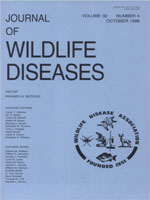In the first (July 1989) of two experiments, each of three bighorn sheep (Ovis canadensis) and three domestic sheep, respectively, was exposed to 25, 150, or 300 infective third-stage larvae (L3) of the meningeal worm, Parelaphostrongylus tenuis. Two bighorn sheep had temporary mild paresis and lumbar weakness; one developed paralysis and died suddenly 32 days after exposure. Adult P. tenuis were found deep within the brain and spinal cord of the one latter sheep. A generalized inflammatory response, characterized by subdural lymphoid aggregations adjacent to spinal nerve roots, was seen in the spinal cord of most domestic and bighorn sheep. In the second experiment (September 1990), each of six domestic sheep lambs and five white-tailed deer (Odocoileus virginianus) fawns was exposed to a single dose of 15 to 125 L3 of meningeal worm. Clinical signs were seen in only one sheep; it was dull and depressed. No worms were found in this sheep. One dead adult meningeal worm was found on the brain of another sheep. First-stage larvae and adult meningeal worms were found in all deer.
How to translate text using browser tools
1 October 1996
MENINGEAL WORM IN EXPERIMENTALLY-INFECTED BIGHORN AND DOMESTIC SHEEP
M. J. Pybus,
S. Groom,
W. M. Samuel

Journal of Wildlife Diseases
Vol. 32 • No. 4
October 1996
Vol. 32 • No. 4
October 1996
Bighorn Sheep
domestic sheep
experimental study
meningeal worm
Ovis canadensis
Parelaphostrongylus tenuis




